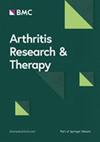Dystrophic calcinosis: structural and morphological composition, and evaluation of ethylenediaminetetraacetic acid (‘EDTA’) for potential local treatment
IF 4.9
2区 医学
Q1 Medicine
引用次数: 0
Abstract
To perform a detailed morphological analysis of the inorganic portion of two different clinical presentations of calcium-based deposits retrieved from subjects with SSc and identify a chemical dissolution of these deposits suitable for clinical use. Chemical analysis using Fourier Transform IR spectroscopy (‘FTIR’), Raman microscopy, Powder X-Ray Diffraction (‘PXRD’), and Transmission Electron Microscopy (‘TEM’) was undertaken of two distinct types of calcinosis deposits: paste and stone. Calcinosis sample titration with ethylenediaminetetraacetic acid (‘EDTA’) assessed the concentration at which the EDTA dissolved the calcinosis deposits in vitro. FTIR spectra of the samples displayed peaks characteristic of hydroxyapatite, where signals attributable to the phosphate and carbonate ions were all identified. Polymorph characterization using Raman spectra were identical to a hydroxyapatite reference while the PXRD and electron diffraction patterns conclusively identified the mineral present as hydroxyapatite. TEM analysis showed differences of morphology between the samples. Rounded particles from stone samples were up to a few micron in size, while needle-like crystals from paste samples reached up to 0.5 µm in length. Calcium phosphate deposits were effectively dissolved with 3% aqueous solutions of EDTA, in vitro. Complete dissolution of both types of deposit was achieved in approximately 30 min using a molar ratio of EDTA/HAp of ≈ 300. Stone and paste calcium-based deposits both comprise hydroxyapatite, but the constituent crystals vary in size and morphology. Hydroxyapatite is the only crystalline polymorph present in the SSc-related calcinosis deposits. Hydroxyapatite can be dissolved in vitro using a dosage of EDTA considered safe for clinical application. Further research is required to establish the optimal medium to develop the medical product, determine the protocol for clinical application, and to assess the effectiveness of EDTA for local treatment of dystrophic calcinosis.营养不良性钙化症:结构和形态组成,以及乙二胺四乙酸('EDTA')局部治疗潜力评估
对从 SSc 患者身上提取的两种不同临床表现的钙基沉积物的无机部分进行详细的形态分析,并确定适合临床使用的化学溶解这些沉积物的方法。使用傅立叶变换红外光谱(FTIR)、拉曼显微镜、粉末 X 射线衍射(PXRD)和透射电子显微镜(TEM)对两种不同类型的钙化沉积物(糊状和石状)进行了化学分析。用乙二胺四乙酸(EDTA)滴定钙化样本,以评估 EDTA 在体外溶解钙化沉积物的浓度。样品的傅立叶变换红外光谱显示出羟基磷灰石的特征峰,其中磷酸盐和碳酸盐离子的信号都被识别出来。利用拉曼光谱进行的多晶型表征与羟基磷灰石参照物完全相同,而 PXRD 和电子衍射图则确定了羟基磷灰石矿物的存在。TEM 分析显示了不同样品之间的形态差异。石材样品中的圆形颗粒大小可达几微米,而浆状样品中的针状晶体长度可达 0.5 微米。在体外,3% 的乙二胺四乙酸(EDTA)水溶液可有效溶解磷酸钙沉积物。EDTA/HAp 的摩尔比≈ 300 时,两种沉积物都能在约 30 分钟内完全溶解。结石和糊状钙基沉积物都由羟基磷灰石组成,但组成晶体的大小和形态各异。羟基磷灰石是与 SSc 相关的钙化沉积物中唯一存在的多晶体。羟基磷灰石可在体外溶解,使用的 EDTA 剂量被认为对临床应用是安全的。还需要进一步研究,以确定开发医疗产品的最佳介质,确定临床应用方案,并评估 EDTA 用于局部治疗营养不良性钙化症的效果。
本文章由计算机程序翻译,如有差异,请以英文原文为准。
求助全文
约1分钟内获得全文
求助全文
来源期刊

Arthritis Research & Therapy
RHEUMATOLOGY-
CiteScore
8.60
自引率
2.00%
发文量
261
审稿时长
14 weeks
期刊介绍:
Established in 1999, Arthritis Research and Therapy is an international, open access, peer-reviewed journal, publishing original articles in the area of musculoskeletal research and therapy as well as, reviews, commentaries and reports. A major focus of the journal is on the immunologic processes leading to inflammation, damage and repair as they relate to autoimmune rheumatic and musculoskeletal conditions, and which inform the translation of this knowledge into advances in clinical care. Original basic, translational and clinical research is considered for publication along with results of early and late phase therapeutic trials, especially as they pertain to the underpinning science that informs clinical observations in interventional studies.
 求助内容:
求助内容: 应助结果提醒方式:
应助结果提醒方式:


